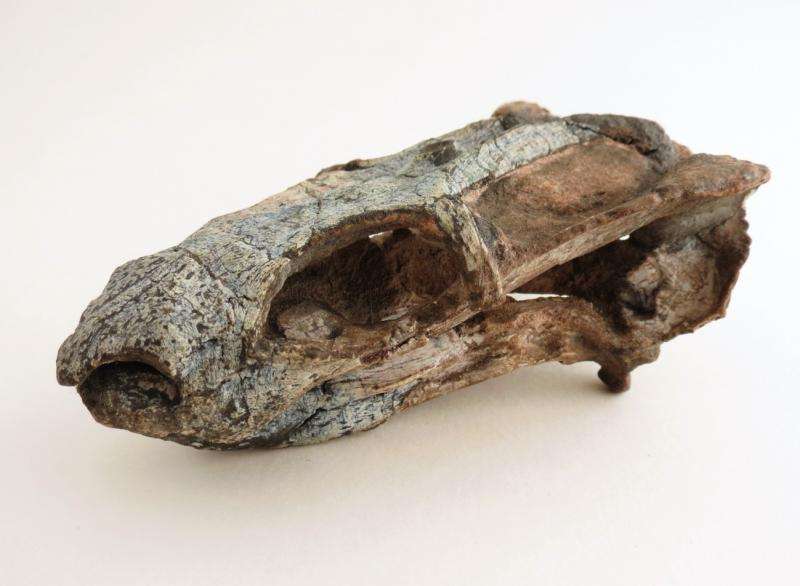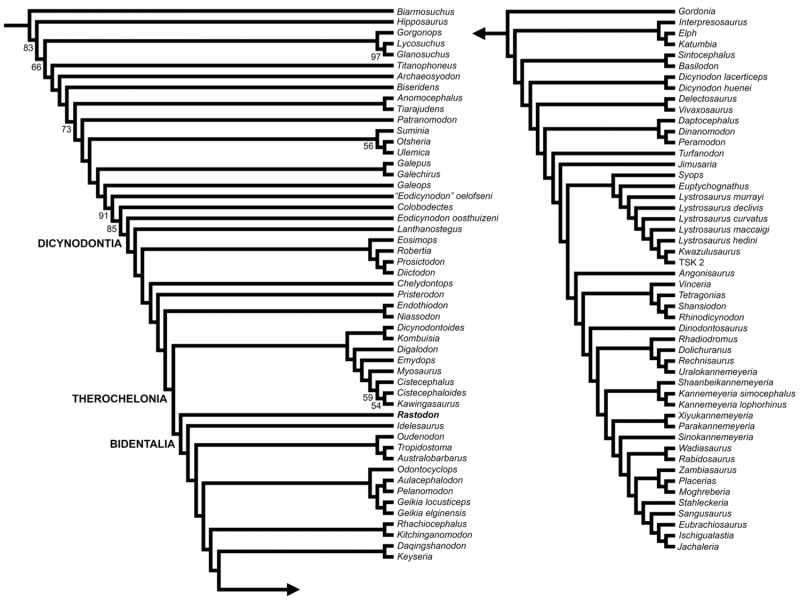Unusual tusks in a new species of dicynodont from the Permian of Brazil

May has been a spectacularly busy month. And a lot of awesome research was recently published on PLOS ONE and other open access journals (check out our Fossil Friday Roundup feature for lists of the latest publications and news) while I was out traversing across the state of Utah (looking at fish fossils and dinosaur tracks – more on that later!). But now that I've returned from traveling (for now), and Fossil Friday Roundup is successfully off and running, I'm back and ready to share with you the latest paper, published today in PLOS ONE.
The study, by authors Alessandra Boos, Christian Kammerer, Cesar Schultz, Marina Soares, and Ana Ilha, examines a beautifully preserved dicynodont skull from the Permian of Brazil, and with this skull comes a lot of new information and implications regarding the evolutionary relationships of these herbivorous therapsids that existed globally from the Middle Permian through the end of the Triassic. The richest record with regard to abundance and diversity of these organisms is recorded from the Beaufort Group of South Africa, but the record from Brazil has been less extensive, with only one Permian-age specimen (Endothiodon) previously recorded from the Paraná Basin, and three genera from the Triassic.
This new species, dubbed Rastodon procurvidens by the authors, is now the second known taxon from the Permian of Brazil. The description is based on a single specimen, but a beautiful one at that, with an almost complete skull and lower jaws. It was collected on a private farm in Rio Grande do Sul, from the Guadalupian/Lopingian Rio de Rasto Formation. The skull is slightly crushed dorsoventrally, but is still so well preserved that it is easy to distinguish characteristics that define it as a dicynodont.

What makes Rastodon unusual, however, is it's unique arrangement of the tusks. Unlike other dicynodonts, the tusks of Rastodon are extremely small and curved forwards, with the tip of each tusk directed towards the front of the snout. The authors note that this is not due to pathological or taphonomical deformation because this morphology is present on both sides of the skull and fits nicely into an embayment that is present on the caniniform process of Rastodon, and each tooth displays fine striations that match the curvature of the tooth, with no cracks that would suggest deformation of the teeth.
Procurved teeth are present in one other taxon, the study notes. Abajudon, a dicynondont from Tanzania, possesses procurved postcanines, not tusks like Rastodon. In both instances, however, the function or purpose of these teeth remains unclear. Boos et al (2016) does note that these unusual tusks must have played a role when chewing because they inner (lingual) surface would have contacted the lower jaw during mastication.
The phylogenetic study of Boos et al (2016) recovered Rastodon as being a member of the dicynodont sublcade Bidentalia. The skull of Rastodon is very generalized when compared to other members of Bidentialia, but nevertheless is united with this group based on some shared derived characters outlined in the paper. More importantly what this study suggests is that Bidentalia must have split by the middle Permian, but this split must have occurred outside of Africa, as members of this group are absent in Guadalupian-age rocks of Africa. Rastodon represents the first basal bidentalian from the Middle Permian, as all other basal bidentalian dicynondonts are late Permian in age.
This beautiful specimen illustrates the need to examine more middle Permian deposits from South America, Asia, and African basins outside of South Africa. The origin of this diverse clade is still a larger mystery, and as the discovery of Rastodon shows, there is still much to learn about the origin and evolution of these unusual herbivorous tetrapods.
More information: Alessandra D. S. Boos et al. A New Dicynodont (Therapsida: Anomodontia) from the Permian of Southern Brazil and Its Implications for Bidentalian Origins, PLOS ONE (2016). DOI: 10.1371/journal.pone.0155000
Journal information: PLoS ONE
Provided by PLOS Blogs
This story is republished courtesy of PLOS Blogs: blogs.plos.org.





















